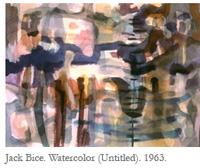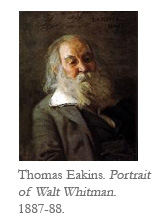Image & Music as Text
While Barthes’s theory of the Text and the work is primarily applied to written texts, it is not restricted to this medium. Meaning and value occur in a variety of cultural forms; so too do the seven propositions that Barthes identifies with the Text and the work. Music, photography, painting, film, and cultural events are among the forms that Barthes’s theory can be applied to.
Image
 This untitled avant-garde painting by Jack Bice is an example of a different medium functioning as the Text. Like the Text, this painting is irreducibly plural and cannot be interpreted. The observer (the reader) is not reliant on the artist’s (the author) declared intentions — even the title is not declared — thus the painting is actively produced by the observer rather than being passively consumed. [View a larger version of Bice’s painting.]
This untitled avant-garde painting by Jack Bice is an example of a different medium functioning as the Text. Like the Text, this painting is irreducibly plural and cannot be interpreted. The observer (the reader) is not reliant on the artist’s (the author) declared intentions — even the title is not declared — thus the painting is actively produced by the observer rather than being passively consumed. [View a larger version of Bice’s painting.]
 In contrast to Bice’s painting, Thomas Eakins’s “Portrait of Walt Whitman” is an example of a painting functioning as the work. Because this painting is identified by genre (psychological realism), artist/owner (Thomas Eakins), and content (Walt Whitman), it becomes a commodity. The reader cannot actively engage in the production of this work because its meaning, both literal and concealed, is predetermined. [View a larger version of Eakins’s painting.]
In contrast to Bice’s painting, Thomas Eakins’s “Portrait of Walt Whitman” is an example of a painting functioning as the work. Because this painting is identified by genre (psychological realism), artist/owner (Thomas Eakins), and content (Walt Whitman), it becomes a commodity. The reader cannot actively engage in the production of this work because its meaning, both literal and concealed, is predetermined. [View a larger version of Eakins’s painting.]
Music
Music parallels the evolution of the Text. While traditional music is defined by the player (the author) and the listener, the distinction between these two roles has been altered by new forms of music. Post-serial music, music produced in reaction to serialism (mathematized music), is a prime example of music functioning as a Text. The listener, also known as the interpreter, becomes a co-author of the score and engages in a practical collaboration.
An example of post-serial music is the work of minimalist composer Tom Johnson. Johnson’s music allows the reader to engage in its creation because it is not limited by predetermined meaning or structure. Most of his music is not defined by a specific instrument, octave, or transposition. It lacks a linear structure and any part of the composition can be played at any time by any number of musicians.
Listen to examples of Johnson’s work:









